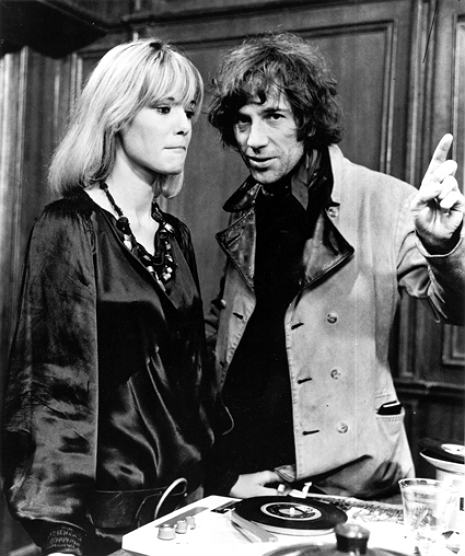
Donald Cammell with Anita Pallenberg on the set of “Performance.”
Though he only directed two films that are truly extraordinary, Donald Cammell will always hold a special place on my list of the all-time great cinematic mindfuckers.
Dangerous Minds readers will undoubtedly be familiar with the hugely influence Performance, but Cammell’s last film, the darkly witty and perverse Wild Side, deserves to find a wider audience. It was butchered by its original production company and released in a bastardized form that so depressed the already mentally fragile Cammell it sent him over the edge and he killed himself in 1996.
Wild Side was re-released in 2000 in a version that comes close to Cammell’s original cut. Cammell’s close friend editor Frank Mazzola managed to gather together the “lost” footage from Wild Side and reconstruct it in a form that approximates Cammell’s vision. It is available here as an import DVD. For some unfathomable reason the director’s cut has never been released in any form in the USA. I did manage to see it years ago at a Cammell film fest in NYC. It features one of Christopher Walkens’ best and most bizarre performances in a career of bizarre performances. Trust me when I tell you, you’ve never seen Walken at his weirdest until you’ve seen him in a kimono and a long black wig.
Wild Side is cut from the same dark cloth as David Lynch’s Blue Velvet. But I can’t stress enough the fact that the butchered version available on Amazon and elsewhere is worthless. Avoid it like a bad case of the clap.
Here’s a clip from Wild Side with Anne Heche, Steven Bauer and Walken to whet your appetite. “Off with the Calvins.”
Cammell got his professional start in the arts as a painter and photographer in the swinging London scene of the 1960s. He lived the life of a rock star, looked the part and was prone to the hedonistic excesses of the times as well. He worked with filmmaker Nic Roeg to create the greatest head movie of all time, Performance. Artistic recognition led to a series of disappointments in Hollywood and Cammell’s life quickly veered toward a sad end. His story is compelling and tragic and in this documentary his fascinating life unfolds like one of his movies.

Jiving nicely with my feedback-obsessed episode of the Dangerous Minds Radio Hour today is this marvelous and engaging sound art/performance piece entitled Diptych by Michelle Temple & Aiwen Wang-Huddleston. There’s a lot to love here but mainly it’s the sense of fun that recalls the best of the Fluxus artists and especially that it doesn’t involved any laptops, iPads or iPhones. It’s a really nice vocabulary of sounds in that combination of materials as well.
With thanks to Dave Madden
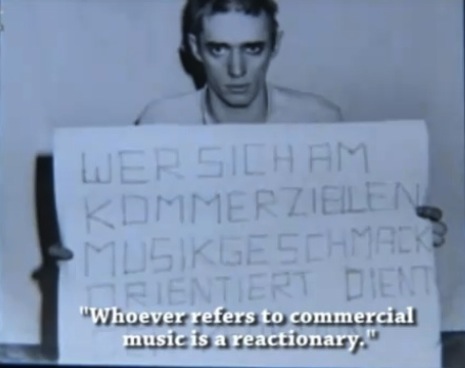
Few artists personify the spirit of demoralized post-‘60s Europe like Blixa Bargeld, the frontman for legendary German post-industrial music outfit Einstürzende Neubauten. Born in Berlin two years before the Wall went up, Bargeld leveraged his destroyed looks and singular voice—which Nick Cave likened to the sound of strangled cats or dying children—to make Neubauten the key progenitors of Western machine-age art.
As brought to our attention by TwentyFourBit‘s esteemed Peter Henry Reed (and fortunately for us English-speaking-only dopes), YouTuber Nevaree has seen fit to add English subtitles to Birgit Herdlitschke’s fascinating 2008 Blixa doc, Mein Leben. It traces Bargeld’s journey from young, torn-up Berlin musician to cosmopolitan middle-aged avant-garde artiste, actor, and gourmet, and features both answers to the heroin question and a visit with his charming mutti.
Mein Leben part 2 | Mein Leben part 3 | Mein Leben part 4
After the jump: Blixa grimaces at Neubauten live mistakes…

Is Tracey Emin any good? That’s the question at the heart of Anne-Claire Pilley’s documentary about the celebrated and controversial artist. Tracey Emin - Sex, Success and Celebrity, which was made to coincide with the 2008 retrospective Tracey Emin: 20 Years, pits two opposing voices against each other: neo-classical sculptor Alexander Stoddart, who claims Emin’s work is “horrendous, exploitative, and insincere,” a mix of “cynicism and sentimentalism”; and Guardian scribe and novelist, Bidisha who believes Emin is “a charisamtic, powerful woman,” who produces “real art work of value and tremendous beauty.”
Emin is a fine subject for this kind of documentary, as she has divided audiences and critics since her first solo exhibition at the White Cube Gallery in 1993, and while many may think the argument over Emin’s talent is redundant, her retrospective, Tracey Emin: 20 Years, proved it was very much alive and kicking. Laura Cumming in the Guardian, wondered whether the show was “self-pity or self-parody”:
Tracey Emin: 20 Years is an assault of a show. There is no escape from the agony. The corridors are lined with images of abuse, betrayal, sickness and abortion, tales from hell retold in embroidered banners and neon. The galleries are crammed with martyr’s relics: hospital tags, bloody plasters, painkillers, failed contraceptives, the famous bed with its stained knickers and stubbed fags - supporting evidence to further jeremiads in prose and video. The soundtracks bleeding from one room to the next alone would make you scream, except that Emin does it for you: at the top of her lungs and naked in Norway, in homage to Edvard Munch.
It has to be a joke, this video, doesn’t it? Emin couldn’t possibly expect us to take this absurd literalism seriously - or could she? This is a question for any visitor to her retrospective. Go round it solemnly by all means (and I never saw so much respectfulness as in Edinburgh), but every now and again ask yourself whether Emin mightn’t actually be sending herself up.
While, Lynne Walker in the Independent said, “Tracey Emin’s work crude and self-centered? That’s missing the point”:
...despite the graphic content of some of the work, the sequence of pictures of women with splayed legs, or the in-your-face curses and more enigmatic phrases on the beautiful and hugely detailed blankets, to dismiss her work as crude or self-centred is to miss the point. That’s just one aspect of Emin. By far the most touching examples of her work are Uncle Colin – the piece that, at least on the day I spoke to her, she would most like to save if all else were to be destroyed. A favourite relative whose sudden death traumatised her is immortalised in text and photos, just as the spirit of her grandmother hovers over the colourful There’s a Lot of Money in Chairs – mainly stuffed down the back of them, in this case. The bird drawings sing off the wall, while one of the most fascinating exhibits involves tiny photographic reproductions of work she destroyed in 1990.
It’s brave of Emin to expose so much of herself over such a long period. A short DVD, Why I Never Became a Dancer, tells a bigger story, while the reproduction, on a smaller scale, of Exorcism of the Last Painting I Ever Made from 1996 is such a personal insight that it provokes wry smiles and even a tear.
Tracey Emin - Sex, Success and Celebrity was made as part of the BBC’s Artworks (which has a ghastly opening title sequence) strand, and includes interviews with Emin, and various contributors, and discussions on Emin’s works including Uncle Colin, Why I Never Became a Dancer, A Conversation with My Mum and It’s Not The Way I Want to Die.
Before you watch, here are 10 facts about Tracey Emin, as found on her website.
1. Tracey Emin might not be the kind of artist your granny would like. Her autobiographical style of work is all about exposing the kind of things about herself that most people would be too ashamed to reveal.
2. Her confessional subjects include abortions, rape, self-neglect and promiscuity, sometimes expressed with the help of gloriously old-fashioned looking, hand-sewn applique letters. Her dad quite likes the sewing, because it reminds him of his own mum.3. One of her installations, called Everyone I Have Ever Slept with 1963-1995 is a tent, into and onto which she has sewn all these people’s names.
4. Some see poetry in the titles of her work. They include: You Forgot to Kiss My Soul; Every Part of Me Is Bleeding; My Cunt is Wet With Fear; and I Need Art Like I Need God. There is no Still Life With Bowl of Apples, as far as we know.
5. Emin has been accused of cynically exploiting the public’s darkest levels of voyeurism.
6. But her honesty can be disarming. She once told Observer interviewer Lynn Barber that the first thing she did when she started making money was to buy medical insurance, because: “I’m sickly and I get run down and I have very bad herpes, and I like knowing that the doctor’s there.”
7. Emin’s first move into the public eye was opening a shop in London’s Bethnal Green called, er, The Shop, with fellow artist Sarah Lucas. Emin’s stock included letters she’d written and ashtrays with pictures of Damien Hirst’s face stuck to the bottom of them.
8. Emin was the inspiration - if that’s the right word - for a latter day art movement called Stuckism, which is devoted to advancing the cause of painting as the most vital means of addressing contemporary issues. The movement was founded by her ex-boyfriend Billy Childish, to whom she had once said: “Your paintings are stuck, you are stuck! Stuck! Stuck! Stuck!”
9. White Cube curator Jay Jopling spotted her in 1994 and the big time called. She came to wider public attention during a live Channel 4 Turner Prize debate in 1997. A very inebriated Emin mumbled incoherently that “no real people” would be watching and that she wanted to go be with her mum and friends.
10. Two years later, “Mad Tracey from Margate” (her words) was shortlisted for the Turner Prize for an installation entitled My Bed, a testimony to her self-neglect and over-indulgence. She didn’t win, but Charles Saatchi paid £150,000 for it.
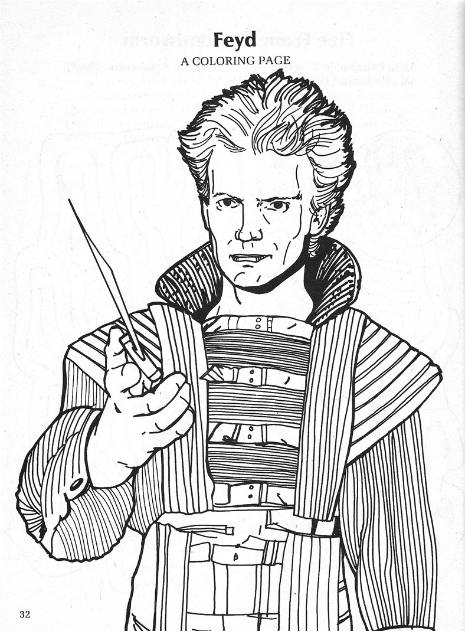
Some pages from the Dune Coloring & Activity Book published in 1984. Written by Arlene Block and illustrated by Michael Nicastre, the coloring book offered hours of enjoyment to Dune-loving kindergartners. Connect the dots to see what Paul can’t live without!

More images after the jump…

Mark Dery writes in today’s New York Times of the continuing influence of Edward Gorey, author of Amphigorey
and The Gashlycrumb Tinies
. Dery is currently writing a biography of the gruesome author and illustrator, a book the linguistically exact cultural critic seems to have been born to write:
Gorey was born to be posthumous. His poisonously funny little picture books — deadpan accounts of murder, disaster and discreet depravity, narrated in a voice that affects the world-weary tone of British novelists like Ronald Firbank and Ivy Compton-Burnett — established him as the master of high-camp macabre.
Told in verse and illustrated in a style that crosses Surrealism with the Victorian true-crime gazette, Gorey stories are set in some unmistakably British place, in a time that is vaguely Victorian, Edwardian and Jazz Age all at once. Though Gorey was a 20th-century American, he conjured a world of gramophones and cars that start with cranks, of boater-hatted men in Eton collars knocking croquet balls across the lawn while sloe-eyed vamps in cloches look on, and sinister things sink, bubbling, into the reflecting pond. His titles are instructive: “The Fatal Lozenge,” “The Deadly Blotter,” “The Hapless Child,” “The Haunted Tea-Cosy.”
Read more at The New York Times.
Below, Edward Gorey’s iconic opening sequence for PBS’s Mystery! television anthology:

Over the past couple of years, the hyper-ascension of everyone’s favorite street artist has led to all kinds of phenomena, including the mainstreaming of the artform and, yes, its commodification.
In the case of Banksy, the adventure of anonymously creating public pieces is being matched by the similar adventure of swiping and selling them. LA Weekly photographer Ted Soqui’s report on the theft of Banksy’s Caution (after it got tagged) in East L.A. (pictured in sequence L-R above) put me in the mind of Jamaican edge-culture worker Peter Dean Rickards’s 2008 jacking of a larger piece that ol’ Mr. Anonymous tossed onto the outside wall of a Kingston pub. Rickards—who does business as Afflicted Yard—shot the video below, which also documents the amazing dynamics that can happen when a dozen Jamaican men work on the same project.
The Afflicted Yard: The Rock from Peter Dean Rickards on Vimeo.
After the jump: yes, a documentary about how to steal and sell a Banksy…
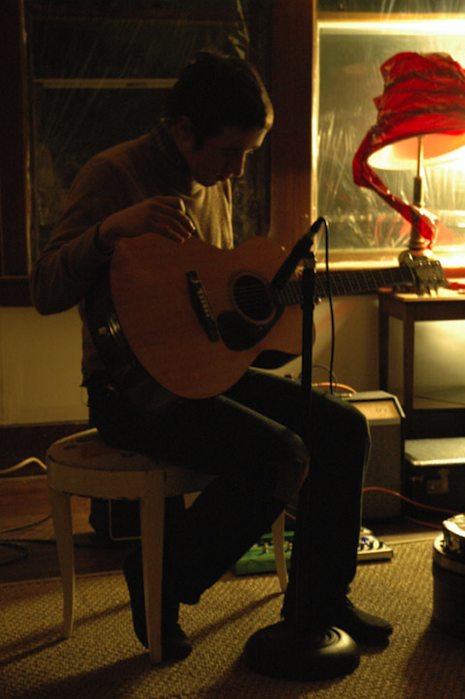
I was just introduced to this lovely clip made by one Geoff Mullen today by the venerable composer and music seller Keith Fullerton Whitman who pointed out how well the simple manipulated old school consumer model video feedback suited the layers of noisy, modal guitars. All of which combine to really hit the spot for me today. Hope you enjoy it too.

Simply stunning work entitled “Music Concert Series” by Los Angeles-based artist Hyejung Bae. The Yellow Magic Orchestra poster is my favorite.
Poster series for a concert of electronic musicians playing classical music with digital instruments. Newspaper illustrations from the 1800’s combine with contemporary optical patterns to represent the timeless value of classical music and its digital interpretation
.
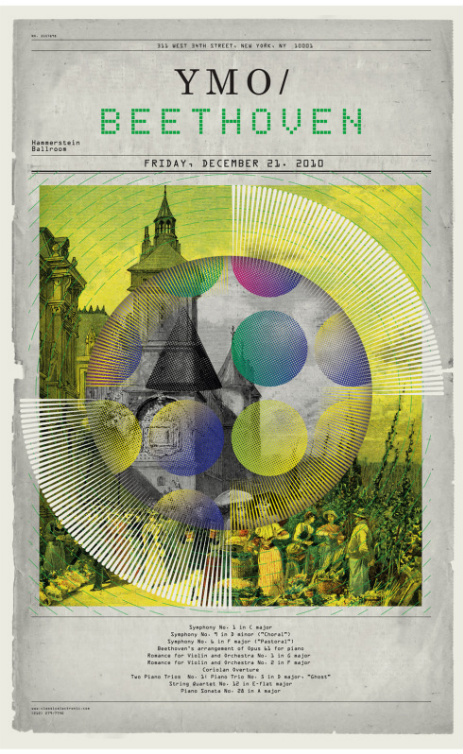
One more after the jump…